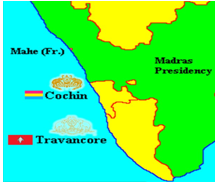

Context
Recently, the Kerala Assembly has passed a resolution urging the Centre to rename the state as “Keralam” in the Constitution and all office records.
About
Key-Points in Resolution:
- The resolution presented by Kerala government mentioned that, the name of the state in Malayalam is
- States were formed on the basis of language on November 1, 1956. That day is also observed as Kerala formation day.
- The demand for a united Kerala for all Malayalam-speaking communities has been strongly raised right from the days of the freedom struggle.
- However, the name of our state in the first Schedule of the Constitution has been written as Kerala.
- Thus the Assembly is unanimously requesting the Union Government to take immediate steps under Article 3 of the Constitution to change the name of the state toKeralam.
Historical Backings to the name Keralam:
- The earliest epigraphic record that mentions Kerala is Emperor Asoka’s Rock Edict II of 257 BC.
- The inscription refers to the local ruler as Keralaputra (Sanskrit for “son of Kerala”), and also “son of Chera” referring to the Chera dynasty.
- About ‘Keralam’, scholars believe it could have originated from ‘Cheram’.
Demands of Modern State- on the basis of language:
- It was in the 1920s that the Aikya (unified) Kerala movement gathered momentum and a demand for a separate state for Malayalam-speaking people came up.
- It aimed at the integration of Malabar, Kochi and Travancore into one territory.
- The Keralites who spoke the same language, shared common cultural traditions, and were unified by the same history; rituals and customs were inspired by the freedom movement to ask for unification and integration.
Why demands for states on linguistic basis emerged in Kerala?
- The merger and integration of princely states was a major step towards the formation of the state of Kerala after Independence.
- On 1 July, 1949, the two states of Travancore and Kochi were integrated, heralding the birth of the Travancore-Cochin State.
- When it was decided to reorganise states on a linguistic basis, the State Reorganisation Commission of the Union Government recommended creation of the state of Kerala.
- The Commission under Syed Fazl Ali recommended the inclusion of the district of Malabar and the taluk of Kasargod to the Malayalam-speaking people’s state.
- It also recommended the exclusion of the four Southern taluks of Travancore vizTovala, Agastheeswaram, Kalkulam and Vilayankode together with some parts of Shenkottai (all these taluks now part of Tamil Nadu).
- The state of Kerala came into being on November 1, 1956.
- In Malayalam, the state was referred to as Keralam, while in English it was
How states can be renamed in India?
- To change the name of a state, approval from the Centre’s Ministry of Home Affairs (MHA) is required.
- The proposal has to first come from the state government.
- A Constitutional amendment becomes necessary to affect this change.
- The Union Ministry of Home Affairs (MHA) then takes over and gives its consent after it receives No Objection Certificates (NOCs) from several agencies such as the Ministry of Railways, Intelligence Bureau, Department of Posts, Survey of India and Registrar General of India.
- If the proposal is accepted, the resolution, introduced as a Bill in the Parliament, becomes a law and the name of the state is changed thereafter.
Constitutional Provisions:
- Article 3 of the Constitution; explicitly lays down a procedure to alter the area, boundaries, or name of a state.
- When the name of the State is changed or a new State is created, the Constitution of India is required to be amended by Parliament by a Simple majority as under Articles 107 & 108 of Constitution.
- The Parliament has the power to change the name of a state. The Constitution of India gives the parliament power to alter the name of a state under Article 3.
|
The State reorganization Commission: The Fazl Ali Commission, also known as the States Reorganization Commission, was formed in 1953 to address the demands of different states in India for the reconstitution of states along linguistic lines. The commission was established in response to the popular demand for the formation of states based on common language and culture, which was also sponsored by the Indian National Congress before independence. The commission was headed by Justice Fazl Ali, with K.M. Pannikar and H.N. Kunzru as members. |


